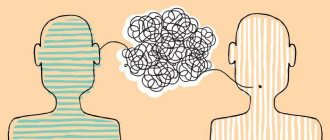Communication skills are a set of human abilities that ensure effective interaction with other people. Effective communication comes down to two main principles: the ability to correctly understand the interlocutor, that is, to correctly explain to oneself what he said, and the ability to correctly convey information, that is, to express exactly the thought that was planned.
Communication with other people, that is, communication, according to many psychologists, for example, Vygotsky, Elkonin, is the basis of human development and, in particular, the foundation of personality formation. In addition, communication is responsible for a number of other functions. These include managing one’s own behavior, fulfilling the need for communication, ensuring psychological well-being, organizing joint activities with other people, etc.
Communication skills are a necessity for a person living in society, since he has to interact with a large number of people, solving problems from different areas of life: from going grocery shopping to complex business negotiations. Communication skills are also responsible for the success of completing the task.
Low communicative competence leads to interpersonal conflicts and the appearance in a child or adult of a feeling of alienation, isolation, and uselessness, therefore the development of communication skills is important from a person’s earliest childhood.
In addition, there are a number of professions in which communication is the main method of work. These include professions from the fields of journalism, psychology, pedagogy, marketing and many others. Employees in these areas are required to have highly developed communication skills. However, it is also important for people not associated with these areas to develop effective communication skills, which will become the basis for social fulfillment, psychological satisfaction and help in the formation of interpersonal connections.
Formation of communication skills
The foundations of communication skills are laid in preschool age, when the child actively communicates with parents, peers and other people. In the process of communicating with adults, the child perceives and assimilates the model of interaction, and in communication he learns norms and rules of behavior. The child is actively exploring the social world, and he needs an adult who will explain the laws of this world and expand the child’s ideas about the space around him. Thus, the child assimilates those images that are inherent in the adult with whom the child interacts. He adopts facial expressions, gestures, vocalizations, the way of speaking and thinking of an adult. In addition, he copies the behavior of an adult in certain situations.
Also, the communication skills of a preschooler are formed in play, role-playing activities, which are leading for this age. During play, the child’s social, personal and mental development occurs. During the game, he reproduces situations in which adults participated and tries out their roles. In this way, the child participates in an imaginary social life and develops his communication skills.
When communicating, the child tries out various verbal and nonverbal behavior, learns models of effective interaction in various situations, learns to start, maintain and end a dialogue, develops the ability to listen to another person, formulate and ask a question, support a group conversation, etc.
Work on your acting skills
Communication abilities are, in turn, a wealth of different intonations and gestures. This is what characterizes people as representatives of society. A sociable person is an excellent storyteller and imitator, who has a taste for juicy detail, for details. He prefers variety in life, since it is easy for such a person to move from one social role to another, in addition, he easily adapts to any situation. Such people have charm and know how to please.
Adult communication skills
The formation of communication skills begins in preschool age, but the process of their transformation, correction and improvement continues into adulthood.
The communicative competence of an adult is ensured by a set of abilities. These include:
- Ability to establish and maintain contacts with others;
- The ability to predict a communication situation and its features;
- Ability to respond appropriately to critical statements or provoking behavior;
- Ability to follow a given communication goal;
- Ability to argue your position;
- The ability to refuse, to ask;
- The ability to manage interactions to obtain the necessary information from the interlocutor;
- Ability to provide and receive attention, sympathy, support;
- Ability to make contact and respond correctly to attempts to make contact;
- The ability to create an atmosphere of trust and cohesion in the work team, among family or friends.
When communicating, use not only words, but also non-verbal means of communication
Compared to body language, words are a negligible part of communication.
Psychologists say that through nonverbal means - tone, intonation, body language and facial expressions - a person conveys about 90% of the entire message. If you become more proficient in these aspects, it will become easier for you to convey your message to your interlocutor.
For example, you can learn to speak more emotionally. To emphasize your interest in what the interlocutor is talking about, you can lean slightly in his direction and look into his eyes. If you are positive and open, it will show in your facial expressions and gestures.
Pay attention to your body movements and tone of voice when communicating with others, and adjust them if necessary.
Disorders of development of communication skills
The development of communication skills is influenced by various factors, including upbringing, lifestyle, and the quality of family relationships. There are disturbances in the formation of communication abilities that may arise due to environmental influences. Independent communication skills disorders include:
- No need for communication;
- Tendency to monologue instead of dialogue;
- Failure to take into account the context in which communication occurs;
- The predominance of value judgments instead of providing adequate information, etc.
Impaired communication skills may be part of the pathological symptoms of diseases or developmental deficiencies. In this case, communicative apraxia, communication disorders, and psychotic disorders of communication processes may be noticed.
Diseases characterized by the presence of communication disorders include autism spectrum disorder (ASD), autism, mental retardation, mental retardation, Internet addiction, addiction to mobile devices, etc. People with general underdevelopment of speech, vision and hearing also have difficulties in acquiring successful communication skills.
Show genuine interest in the person you are talking to
When you show sincere interest in your interlocutor, you completely involuntarily begin to listen to him more carefully, trying to understand what he is thinking and feeling. That is, this will help you determine what really interests him.
When you listen to your interlocutor and show interest in his person, you can easily discover that he is not as different from you or as boring as he seemed to you when you met.
Additionally, people will feel more comfortable if they see your interest and attention in them, which will benefit the conversation.
Diagnostics of communication skills
Assessing the ability of adults to communicate effectively is carried out primarily when selecting personnel for a field of activity in which communication is an important tool. Prospective personnel are given a series of psychological tests to determine communication skills, sociability, organizational abilities, and individual components of communicative competence.
In addition, diagnostics of the communication skills of adults can be carried out by a psychologist upon appropriate request in the context of personal consultations to solve various problems, during an examination to identify professional orientation, etc.
Children’s communication skills are diagnosed by a specialist in order to determine whether the child’s development corresponds to normative development and, if necessary, to draw up a psychological correction program. In addition, diagnostics are carried out to determine the most effective method of developing communication skills in a particular child. For example, it has been proven that the communication skills of preschoolers develop better in a role-playing game than in a situation, for example, educational activity or personal communication, since it is the game that is the leading activity of the preschooler, which means that it is in the game that the child’s effective learning and knowledge of the environment takes place peace. But for some children it will be more effective to use art therapy or fairy tale therapy.
Diagnosis of children’s ability to effectively communicate is also carried out if they have developmental disorders in order to identify communication features. Based on this, it is possible to draw up a plan for the child’s adaptation to society, give recommendations to parents, and build a correctional route.
Be understanding about criticism
The ancient Greek philosopher Epictetus advised listening to criticism. If a person senses a grain of truth in it, then it is worth thinking about how to improve.
However, it should be remembered that in the vast majority of cases criticism is a reflection of the emotional state and mood of the critic. Perhaps he was having a bad day. Maybe your pet or child is sick. Perhaps your interlocutor is angry with someone or is jealous of you. Because people are often focused on themselves and their experiences, it is very easy to draw the wrong conclusion.
Remember that the world does not revolve around you. Realize that people think very little about you, about your actions and mood. This knowledge can make your life much easier. Thus, the problem that is associated with the fear of taking the wrong step and saying something wrong (and this supposedly will somehow affect the opinions of others about you) turns into a small obstacle.
Ways to develop children's communication skills
The easiest way to develop effective communication skills in preschoolers is through play. For this purpose, didactic and board games are used, as well as joint play activities with older children, adults and teachers. During it, children learn interpersonal communication, cooperation, can express emotions and relieve internal tension (for example, the exercise “Roar, lion, roar - knock, train, knock”). Children overcome shyness, develop team spirit, and their enthusiasm for communication and interaction grows (for example, the “Magic Wand” exercise).
The socio-game method is also popular for developing the communication skills of preschoolers, which involves organizing activities as a life-game between microgroups of children. The teaching methodology is aimed at developing the individual qualities of children and revealing their creative potential.
Work in microgroups consists of several stages:
- Grouping according to various principles (by gender, month of birth, color of clothing, counting rhyme, etc.);
- Coming up with a name for the team;
- Appointment of a messenger who receives an assignment from the teacher;
- Group independent work process;
- Presentation of results and their joint discussion.
Activities for working in a microgroup can be different. For example, as a task to create a working atmosphere, children can fill out a “Mood Map”, in which children note in what mood they came to class, draw a sun, a leaf or a cloud.
Another example of a game is “Writing by Air.” The leader, whom the children choose themselves, “writes” a number, letter or geometric figure in the air, and other children from the team guess what was written or drawn. At the end of each lesson, children exchange impressions.
In the process of such joint work, cooperation skills, the ability to hear another, the ability to make contact and other important components of a complex of communication skills are effectively developed.
Try to initiate the conversation
Residents of a big city have long been accustomed to pretend that, walking down the street, moving on a bus or on the subway, they do not notice a familiar person or do not recognize him. Downcast eyes, as a rule, indicate a person’s reluctance to communicate with anyone, and this works - they also lose the desire to talk to you.
This adult version of hide and seek causes people to experience more stress and negative emotions than a conversation with even the most undesirable interlocutor.
When you see someone you know, but hide intensely, pretending not to notice him, you are in a state of anticipation. A swarm of questions flash through my head: did he recognize me? Does he want to talk? Or maybe he is in a bad mood and is not in the mood for a conversation? Should I come or not?
In order not to be stressed and not torment yourself once again, it is better to simply come up and start a dialogue, to act as its initiator. You will be surprised how easy it is. If the interlocutor is really not in the mood for a conversation, then you can simply say goodbye and move away.
Types of communications
Organizational communications are a set of communications built on the basis of communication mediated by information about the organization itself, its goals and objectives.
External communications are communications between the organization and the environment. External environmental factors greatly influence the activities of an organization. The communication needs of the organization depend on these factors.
Internal communications are communications within an organization between different levels and departments.
[flat_ab id=”5"]
Formal communications are communications that are determined by the organizational structure of the enterprise, the relationship of management levels and functional departments. The more management levels, the higher the likelihood of information distortion, since each management level can correct and filter messages.
Vertical - Information moves within an organization from level to level as part of vertical communications. It can be transmitted downward, that is, from higher levels to lower ones. The most obvious component of vertical communication in an organization is the relationship between manager and subordinate.
Horizontal communications (between departments) are communications between different departments of the organization. In addition to sharing information downward or upward, organizations need horizontal communications. An organization consists of many departments, so the exchange of information between them is necessary to coordinate tasks and actions. Because an organization is a system of interrelated elements, management must ensure that specialized elements work together to move the organization in the desired direction.
Informal communications . The channel of informal communications can be called a channel for spreading rumors. Since information is transmitted much faster through rumor channels than through formal communication channels, managers use the former for planned leaks and dissemination of certain information or information of the “just between us” type. The reputation of inaccurate information attributed to rumors continues to this day.
Interpersonal communications are oral communication between people in one of the listed types. The nature of interpersonal relations differs significantly from the nature of social relations, since their most important specific feature is their emotional basis. Therefore, interpersonal relationships can be considered as a factor in the psychological climate of the group. The emotional basis of interpersonal relationships means that they arise and develop on the basis of certain feelings that arise in people towards each other.
Downward communication (manager-subordinates).
Communication between the manager and subordinates is associated with clarifying tasks, priorities and expected results; ensuring involvement in solving department problems; with a discussion of work efficiency problems; achieving recognition and rewards for the purpose of motivation; improving and developing the abilities of subordinates; with collecting information about an emerging or real-life problem; notifying a subordinate about an upcoming change; and receiving information about ideas, improvements and suggestions.
Bottom-up (bottom-up) communication
Upward communication serves the function of alerting the organization's management about what is being done at lower levels. In this way, management learns about current or emerging problems and suggests possible options for correcting the situation. Upward exchange of information usually occurs in the form of reports, proposals and explanatory notes.
Intelligence levels
Intellectual level is the same IQ. According to the data obtained as a result of the survey, intelligence levels are presented in the table.
| Above 140 | A person has excellent creative abilities and can achieve significant success in various branches of scientific knowledge. They are known for their outstanding abilities and contribute to science and the development of society as a whole. Representatives: Bill Gates, Stephen Hawking. |
| From 131 to 140 | Very high levels of intelligence, only 3% of the human population possess them. They can be described as very gifted, successful people. They are also capable of achieving heights in science and creativity. Representatives: Nicole Kidman, Arnold Schwarznegger. |
| From 121 to 130 | The rate is above average, observed in 6% of the population. Such people are immediately visible in high schools and universities. Without much effort, they excel in all subjects, are active in social and creative activities, and receive honors diplomas and gold medals. In their chosen professions, such people reach special heights and successfully move up the career ladder. |
| From 111 to 120 | Representatives are very diligent and hardworking people who spend their entire lives trying to learn something new, learn, and develop. There are approximately 12% of such people. |
| From 101 to 110 | An average level of intelligence, which allows a person to achieve noticeable heights, but not great success. There is no need to be upset, because such intelligence can be developed and pumped up, just as athletes build muscle mass. |
| From 91 to 100 | Also average IQ. With due effort, such people are able to study well at school and graduate from university. As a future professional activity, they usually choose mid-level professions that do not require serious intellectual effort. |
| From 81 to 90 | Representatives of this level of intelligence do well or averagely at school. They rarely receive higher education; they prefer to confine themselves to a technical school or college. They work successfully in areas where they need to use physical activity and be able to work with their hands. |
| From 71 to 80 | People usually have mild mental retardation. They graduate from general education schools with average or satisfactory grades and can study in specialized schools. |
| From 51 to 70 | A more serious form of mental retardation, but such people can take care of themselves, perform work that does not require intellectual effort, and be full members of society. They study in specialized schools. |
| From 21 to 50 | This level of intelligence is characteristic of 2% of the population; it is characterized as severe dementia, an average degree of mental retardation. People are not trained, but can cope with basic household things. For more complex manipulations, they require the help of caregivers. |
| Up to 20 | A severe form of mental retardation, people are not amenable to training and education. They exist in their own world; in modern realities they cannot survive without the help of guardians. |










